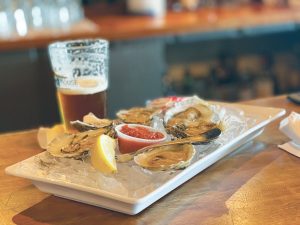 By Paul Suplee, MBA, CEC, PC-3
By Paul Suplee, MBA, CEC, PC-3
I tend to find interesting articles when I am on the road. I was fortunate enough to jump on a commercial fishing trip out of Wanchese, heading out a mere 39 miles offshore to balmy 75-degree water and an ambient air temperature of 60.
It was truly strange as when we left, and when we got back to the dock, it was 40 degrees, raining and absolutely miserable. But out on the gulf stream, it was a different world.
As anglers don’t typically go out around here when it is this cold (the fish are south of us, so there is little point), I had never experienced the dramatic climate shift. That alone made the trip worthwhile.
After a brief moment of trolling, the boat landed a dressed, 264-pound bluefin tuna that is probably in Japan as I type.
It was the fattiest fish of the day leading up to our weigh-in, and that earned it a one-way ticket to the Tokyo auction. It was a good day, and we were in the slip and cleaned up by 3:00 so it was an early day at that. Pretty work, boys. Pretty work.
After an evening of deep rest, I was up early to get back to the real world. I stopped at a couple places on my way up and sampled some wares.
I had never taken the turn to Cape Charles, and I was delighted by the quaint little town that I had heard so much about. As the brewery had just opened, I stopped in for a pint and a pound of steamed shrimp, cooked with garlic butter and one of their fine ales.
A little further up the road, I stopped by one of my favorite haunts, the Island House in Wachapreague. It’s just a few miles off the main drag, so it was a given to stop in for some oysters. And they were good, salty Chincoteague oysters.
If you are not familiar with these, they are world-renowned for their briny and crisp taste, perfectly accentuated with just a touch of lemon and cocktail sauce.
But let’s get back to the article in question. After all, I did open with that hook, so let’s get to it.
As I was sitting there at the bar, it dawned on me that I had never really taken into consideration the rule to never eat or serve oysters with any month not containing the letter ‘R’. I am the “why guy” so I was surprised that I had never taken the time to delve into the matter.
May, June, July and August are apparently out, but the reason that I had never given this a second thought was because I have served and eaten oysters every month of the year since 1983.
During the summer months, my coworker Heidi and I would shuck bushels of the blasted things every day at McGarvey’s.
The reason, and I did know this, is because algae can bloom in the oyster beds and make the oysters dangerous to eat. But, there never seemed to be a shortage of brave souls, willing to tempt fate and their digestive tract, so shuck away we did.
Curious about this, I pulled out my little pocket computer and looked it up. I found a fascinating article from the University of Florida that noted everything above, with an astounding finding; that humans have followed this rule for upwards of 4,000 years.
Scientists have found settlements dating back to this time, with evidence that oysters were a major part of their diet.
In studying the shells, they were able to isolate parasitic snails known to latch onto oyster shells. And in the process of studying these little free-loaders, and understanding their life cycle, the researchers were able to show that the oysters were collected, shucked and presumably eaten in the cooler months, once again the months that have the ‘R’ in the name.
I guess I’m a nerd, but I find this incredibly fascinating.
It’s all in a day’s work. And now, I know and now you do as well. You are more than welcome.
Oysters on the Half Shell
serves 4
24 ea. Salty fresh oysters
1 each lemon
12 oz. Cocktail sauce (recipe follows)
Fresh horseradish, as needed
The first most important thing when shucking oysters is staying safe. If you have never shucked before, watch tutorial videos before, or find a good raw bar with a shucker who is willing to teach you
The second most important thing about shucking is to not destroy the meat. Many times they come mangled and mixed with bits of shell. Take your time and do it right. There is nothing like a plump oyster with some fresh cocktail sauce to make the day a brighter one
Be sure to separate the muscle from the bottom shell, making it easy for the guest to simply pull the oyster out
Serve the oysters on rock salt or ice along with the lemon and cocktail sauce. Serve with optional crackers.
Cocktail Sauce
makes about 1 quart
2 1/2 c. Ketchup
1 c. Horseradish
juice of 2 lemons
1 teaspoon Worcestershire Sauce
1 teaspoon hot sauce (I prefer Hank’s)
1. Combine all ingredients in a bowl and whisk well.
2. Allow to sit in icebox overnight so the flavors come together.
—Paul Suplee is a Professor of Culinary Arts
at Wor-Wic Community College and owner
of boxcar40 and boxcar on main.
Visit him at www.boxcar40.com;
www.boxcaronmain.com
